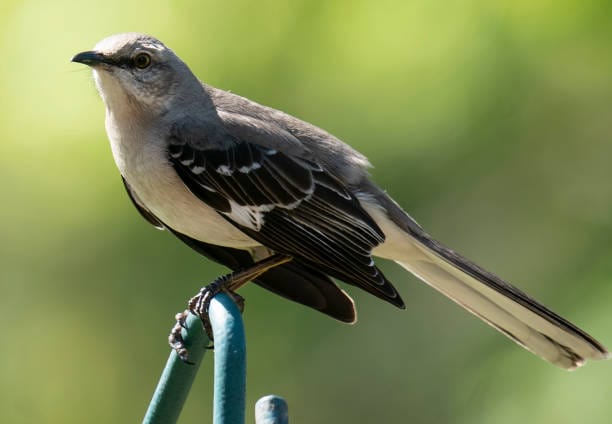All about Birds
All About the Florida State Bird – the Northern Mockingbird
Did you know that the Northern Mockingbird is known for its ability to mimic the sounds of other birds and even mechanical noises? This bird is also known for being one of the most aggressive defenders of its nest, attacking much larger animals if they threaten its young.
Read on to learn more interesting facts about the Northern Mockingbird, the state bird of Florida.
History and Origins: Where Does the Northern Mockingbird Come From?

The Northern Mockingbird is a native bird to the southeastern United States. It was first described in 1758 by Swedish naturalist Carl Linnaeus. The scientific name for this bird is Mimus polyglottos, which means “many-tongued mimic”.
The Northern Mockingbird is a member of the genus Mimus, which contains all mockingbirds. The name “mockingbird” comes from the bird’s habit of mimicking the sounds of other birds, as well as other noises it hears. There are 11 species of the mockingbird in the world, with the Northern Mockingbird being the only one found in North America.
The Northern Mockingbird is the only member of the mimid family in North America. This family also includes the Troupials and the New World Catbirds.
The Northern Mockingbird is the state bird of Arkansas, Florida, Mississippi, Tennessee, and Texas. It was also once the national bird of the United States before the Bald Eagle was chosen to take that honor.
How Did the Northern Mockingbird Become Florida’s State Bird?

Senate Concurrent Resolution No. 3 of the 1927 Florida Legislature designated the Northern Mockingbird as Florida’s state bird. This resolution was approved on April 23, 1927, and signed by Governor John W. Martin.
The Northern Mockingbird was chosen as Florida’s state bird because of its beauty and its melodious song. It is also a very beneficial bird because it eats many harmful insects.
What Does the Northern Mockingbird Look Like?

The Northern Mockingbird is a small songbird with a long tail. It has gray to white plumage and a black “mask” around its eyes. Its wings are long and pointed, and it has a black “thumb” on its wing. The Northern Mockingbird is about 10 inches (25 cm) long and weighs about 2.5 ounces (70 grams).
What Does the Northern Mockingbird Do to Mate and Nest?

The Northern Mockingbird is monogamous, meaning that it mates with only one bird. It breeds from April to July. The female builds a nest of twigs, roots, and grass, lined with feathers and hair. She lays 3 to 5 eggs, which are incubated for 12 to 14 days. The young birds fledge (leave the nest) at about 2 weeks of age.
The Northern Mockingbird is a territorial bird. The male defends his territory by singing, chasing other birds, and even attacking humans who come too close. The size of the territory depends on the availability of food and nesting sites.
How does the Northern Mockingbird Behave?

The Northern Mockingbird is a very curious bird. It will often approach humans and other animals to investigate them. This behavior can sometimes be seen as aggressive, but it is just the bird’s curious nature.
Northern Mockingbird is also known for its mimicry ability. It can imitate the calls of other birds, as well as the sounds of animals and even mechanical objects. This mimicry is used both to communicate with other mockingbirds and to attract mates.
This bird is territorial and will defend its territory aggressively. It will sing loudly and often, to keep other birds away. This behavior can be a nuisance to humans, but it is just the bird’s way of protecting its home.
What Does Northern Mockingbird Eat?

The Northern Mockingbird is an insectivore. It eats mostly insects, but also consumes some berries and other fruits. Its diet varies depending on the season; in the summer, it will eat more insects, while in the winter it will consume more fruits.
It is an opportunistic feeder, meaning that it will take advantage of whatever food is available. This makes it one of the most adaptable birds in North America. It has even been known to eat human food, such as hot dogs, French fries, and pizza crusts!
Conservation Status

Mockingbirds are protected by the Migratory Bird Treaty Act. This act makes it illegal to kill, sell, or trade mockingbirds or their eggs. The Northern Mockingbird is also on the Audubon Society’s list of Common Birds in Decline. This means that the bird’s population is decreasing.
What Can Be Done to Help Protect the Northern Mockingbird?

There are a few things that can be done to help protect the northern mockingbird:
- Encourage others not to disturb nesting birds
- Make sure pets are kept under control and away from nesting areas
- Limit or remove the use of pesticides and herbicides in areas where mockingbirds live
- Contribute to or get involved with organizations that are working to conserve and protect mockingbirds and their habitat.
Final Thoughts
The Northern Mockingbird is a fascinating bird with many unique features. It is interesting to note that this bird is actually quite adaptable and has even been known to eat human food on occasion! Additionally, the fact that the Northern Mockingbird is protected by the Migratory Bird Treaty Act is important to consider in terms of its conservation status. Overall, the Northern Mockingbird is a beautiful and intriguing bird that is worth getting to know!

